|
|

|
 |
| Forum: | Exploration: Moon to Mars |
| Topic: | Gateway: Habitation and Logistics Outpost |
|
| Want to register?
|
If you have previously registered, but forgotten your password, click here.
| | Robert Pearlman | From Northrop Grumman on Twitter: If you're at NASA Johnson Space Center, make sure to catch a glimpse of the Northrop Grumman-built NEXTStep-2 cislunar habitat at its new home. The habitat is designed to support astronauts orbiting the moon and is ready for crew testing later this year. 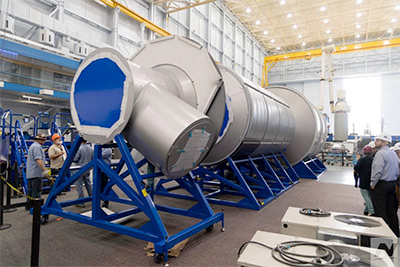 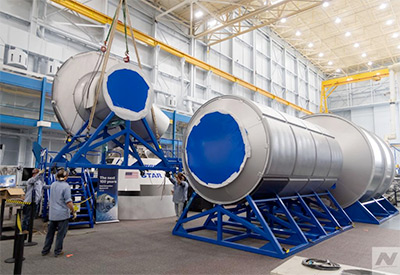
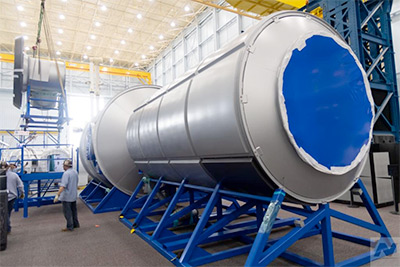
| | Robert Pearlman | NASA release NASA Awards Northrop Grumman Artemis Contract for Gateway Crew CabinNASA has finalized the contract for the initial crew module of the agency's Gateway lunar orbiting outpost. 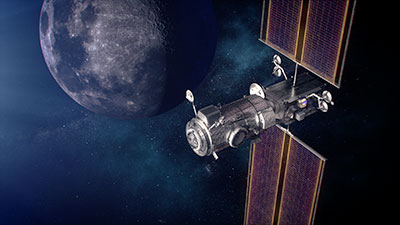 Above: Artist's concept of the Gateway power and propulsion and Habitation and Logistics Outpost, or HALO, in orbit around the Moon. Orbital Science Corporation of Dulles, Virginia, a wholly owned subsidiary of Northrop Grumman Space, has been awarded $187 million to design the habitation and logistics outpost (HALO) for the Gateway, which is part of NASA's Artemis program and will help the agency build a sustainable presence at the Moon. This award funds HALO's design through its preliminary design review, expected by the end of 2020. "This contract award is another significant milestone in our plan to build robust and sustainable lunar operations," said NASA Administrator Jim Bridenstine. "The Gateway is a key component of NASA's long-term Artemis architecture and the HALO capability furthers our plans for human exploration at the Moon in preparation for future human missions to Mars." The HALO will be the pressurized living quarters where astronauts will spend their time while visiting the Gateway. About the size of a small studio apartment, it will provide augmented life support in tandem with NASA's Orion spacecraft. The preliminary design review is one of a series of checkpoints in the design life cycle of a complex engineering project before hardware manufacturing can begin. As the review process progresses, details of the vehicle's design are assessed to ensure the overall system is safe and reliable for flight and meets all NASA mission requirements. This cost plus incentive fee contract allows Northrop Grumman to finalize the design of all systems and subsystems. It also provides for the company to award initial subcontracts for long-lead hardware elements. A second contract action is expected to be definitized by the end of the year for Northrop Grumman to fabricate and assemble HALO for integration with the Gateway's power and propulsion element (PPE) by the end of 2023. These first two elements of the Gateway – HALO and PPE – will launch together in 2023. This is a recent update to the agency's plans to build a sustainable presence at the Moon as part of the Artemis program. The decision to integrate the elements on the ground prior to launch – an outcome of the agency's program status assessment – reduces both cost and technical risks while enhancing the likelihood of mission success by eliminating the need for the two elements to dock in the orbit around the Moon where the Gateway will operate. "We're making significant progress on these first two elements, including incorporation of components from ESA (European Space Agency), the Canadian Space Agency, the Japan Aerospace Exploration Agency, and payloads from our research communities," said Dan Hartman, Gateway program manager at NASA's Johnson Space Center in Houston. "The new plan to integrate the two elements of Gateway demonstrates the capabilities of the agency and our partners to be flexible and reassess plans as needed. By launching the elements together, we're able to significantly reduce Gateway's risk profile and increase cost effectiveness." The PPE, being designed and built by Maxar Technologies, is equipped with high-power, 60-kilowatt solar electric propulsion. In addition to providing power and communications, its substantial maneuvering capabilities will allow the Gateway to change orbits and enable crews to reach any part of the Moon's surface. Northrop Grumman's habitation module, developed through NASA's NextSTEP initiative, is based on its Cygnus spacecraft currently being used to deliver cargo to the International Space Station. The company's existing production capability and manufacturing assets allow it to build the HALO with limited schedule risk. NASA's Launch Services Program will select a launch provider for PPE and HALO by late fall 2020. | | Robert Pearlman | Northrop Grumman release Northrop Grumman Awarded NASA Contract to Provide First Crew Module for Artemis Program GatewayCompany adapts proven Cygnus technology for human habitation Northrop Grumman Corporation has been awarded a contract by NASA to execute the preliminary design and development of the Habitation and Logistics Outpost (HALO). It is to be deployed in lunar orbit as the first crew module of the NASA Gateway, a space station orbiting the moon providing vital support for long-term human exploration of the lunar surface and deep space. This award is a follow-on to the Next Space Technologies for Exploration Partnerships 2 (NextSTEP-2) Appendix A contract. A subsequent modification will be definitized for the fabrication, assembly, and delivery of the HALO module. 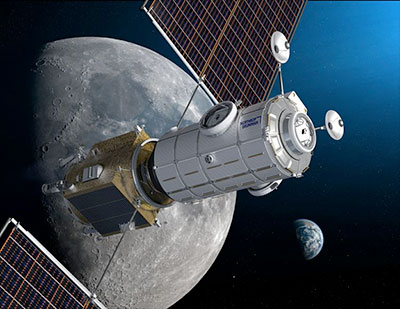 The HALO design is derived from Northrop Grumman's highly successful Cygnus spacecraft, a human-capable vehicle that delivers supplies, spare equipment and scientific experiments to the International Space Station with 13 successful missions to date. "The success of our Cygnus spacecraft and its active production line helps to enable Northrop Grumman to deliver the HALO module," said Steve Krein, vice president, civil and commercial satellites, Northrop Grumman. "HALO is an essential element in NASA's long-term exploration of deep-space, and our HALO program team will continue its work in building and delivering this module in partnership with NASA." Building off of Cygnus' heritage pressurized cargo module, Northrop Grumman added command and control capabilities, including environmental control and life support systems, which, when coupled with NASA's Orion spacecraft capabilities, can sustain up to four astronauts for up to 30 days as they embark on, and return from, expeditions to the lunar surface. By leveraging the active Cygnus production line, Northrop Grumman has the unique capability of providing an affordable and reliable HALO module in the timeframe needed to support NASA's Artemis program. The HALO module represents a critical component of NASA's Gateway serving as both a crew habitat and docking hub for cislunar spacecraft, or spacecraft that navigate between the Earth and the moon. HALO will feature three docking ports for visiting spacecraft, including the Orion spacecraft and other lunar support vehicles. From the first lunar lander to the space shuttle boosters, to supplying the International Space Station with vital cargo, Northrop Grumman has pioneered new products and ideas that have been put into orbit, on the moon, and in deep space for more than 50 years. As a part of NASA's Artemis program, we are building on our mission heritage with new innovations to enable NASA to return humans to the moon, with the ultimate goal of human exploration of Mars. Northrop Grumman solves the toughest problems in space, aeronautics, defense and cyberspace to meet the ever evolving needs of our customers worldwide. Our 90,000 employees define possible every day using science, technology and engineering to create and deliver advanced systems, products and services. | | Robert Pearlman | NASA release NASA Awards Contract to Launch Initial Elements for Lunar OutpostNASA has selected Space Exploration Technologies (SpaceX) of Hawthorne, California, to provide launch services for the agency's Power and Propulsion Element (PPE) and Habitation and Logistics Outpost (HALO), the foundational elements of the Gateway. As the first long-term orbiting outpost around the Moon, the Gateway is critical to supporting sustainable astronauts missions under the agency's Artemis program. After integration on Earth, the PPE and HALO are targeted to launch together no earlier than May 2024 on a Falcon Heavy rocket from Launch Complex 39A at NASA's Kennedy Space Center in Florida. The total cost to NASA is approximately $331.8 million, including the launch service and other mission-related costs. The PPE is a 60-kilowatt class solar electric propulsion spacecraft that also will provide power, high-speed communications, attitude control, and the capability to move the Gateway to different lunar orbits, providing more access to the Moon's surface than ever before. The HALO is the pressurized living quarters where astronauts who visit the Gateway, often on their way to the Moon, will work. It will provide command and control and serve as the docking hub for the outpost. HALO will support science investigations, distribute power, provide communications for visiting vehicles and lunar surface expeditions, and supplement the life support systems aboard Orion, NASA's spacecraft that will deliver Artemis astronauts to the Gateway. About one-sixth the size of the International Space Station, the Gateway will function as a way station, located tens of thousands of miles at its farthest distance from the lunar surface, in a near-rectilinear halo orbit. It will serve as a rendezvous point for Artemis astronauts traveling to lunar orbit aboard Orion prior to transit to low-lunar orbit and the surface of the Moon. From this vantage, NASA and its international and commercial partners will conduct unprecedented deep space science and technology investigations. | | Robert Pearlman | NASA release NASA, Northrop Grumman Finalize Moon Outpost Living Quarters ContractNASA and Northrop Grumman of Dulles, Virginia, have finalized a contract to develop the Habitation and Logistics Outpost (HALO) for Gateway, which will be a critical way station and outpost in orbit around the Moon as part of NASA's Artemis program. 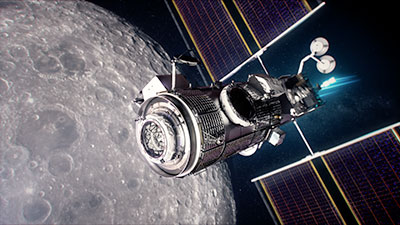 Above: Illustration showing a close-up of the Habitation and Logistics Outpost (HALO), one of the elements of Gateway. NASA and its commercial and international partners are building Gateway to support science investigations and enable surface landings at the Moon, which will help prepare astronauts for future missions to Mars. The firm, fixed-price contract is valued at $935 million. Under the contract, Northrop Grumman will be responsible for attaching and testing the integrated HALO with the Power and Propulsion Element (PPE), being built by Maxar Technologies. Northrop Grumman will also lead the integrated PPE and HALO spacecraft turnover and launch preparation with SpaceX, and support activation and checkout of HALO during the flight to lunar orbit. NASA is targeting November 2024 to launch the integrated spacecraft on a SpaceX Falcon Heavy rocket. "NASA is building the infrastructure to expand human exploration further out into the solar system than ever before, including Gateway, the lunar space station that will help us make inspirational scientific discoveries at and around the Moon. Just as importantly, these investments will help NASA carry out the United States' horizon goal: to further develop and test the technology and science needed for a human trip to Mars," said NASA Administrator Bill Nelson. "The HALO is a critical component of Gateway, and this exciting announcement today brings us one step closer to landing American boots on both the Moon and Mars." HALO is where astronauts will live and conduct research while visiting the Gateway. The pressurized living quarters will provide command and control systems for the lunar outpost, and docking ports for visiting spacecraft, such as NASA's Orion spacecraft, lunar landers, and logistics resupply craft. The HALO module will serve as the backbone for command and control and power distribution across Gateway and will perform other core functions, including hosting science investigations via internal and external payload accommodations and communicating with lunar surface expeditions. HALO also will enable the aggregation of additional habitable elements to expand Gateway capabilities. Immediately after launch, the Heliophysics Environmental and Radiation Measurement Experiment Suite, built by NASA's Goddard Space Flight Center in Greenbelt, Maryland, will begin conducting research outside of the integrated spacecraft. "This is a major step on the path for Artemis, not just for NASA, but for the combined team, including our commercial and international partners," said Kathy Lueders, NASA associate administrator for Human Explorations and Operations. "Gateway will provide unprecedented access to the Moon and symbolizes the expansion of our partnerships into deep space." The integrated PPE and HALO will be the Gateway's foundation, enabling humanity's first permanent outpost in orbit around the Moon. Located tens of thousands of miles from the lunar surface at its farthest point and within easy range of lunar landers at its closest, the Gateway will be in a near-rectilinear halo orbit. This orbit will allow NASA and its international and commercial partners to conduct unprecedented deep space science and technology investigations, and conduct sustainable lunar exploration. "This action puts in place the final contract component of a diverse, multi-faceted team –distributed across the country and within some international partner facilities – working together to create and implement the initial Gateway capability. We are excited to work with Northrop Grumman and all the partners to deliver the cornerstone of sustainable human exploration in cis-lunar space," said Dr. Jon Olansen, NASA's manager of the HALO project. HALO leverages contributions from the Gateway international partners for robust capabilities. Batteries provided by the Japan Aerospace Exploration Agency (JAXA) will power HALO until PPE solar arrays can be deployed and during eclipse periods. Robotic interfaces provided by the Canadian Space Agency will host payloads and provide base points for Canadarm3 robotic operations. ESA (European Space Agency) will provide a lunar communications system to enable high-data-rate communications between the lunar surface and Gateway. With three docking ports, HALO will be the hub for international Gateway expansion in the future, including an international habitat that ESA and JAXA will provide, and an ESA-provided refueling module. The docking ports also will host a human landing system for lunar surface expeditions and logistics resupply spacecraft. As the Gateway hub, HALO will provide power, data, airflow to each of these ports, as well as thermal conditioning to assist future elements and spacecraft in controlling the temperature of their equipment and habitable environment. "Leveraging our success with our Cygnus spacecraft, Northrop Grumman is perfectly positioned to deliver the HALO module, a critical piece for NASA's Artemis program and our journey to the Moon and beyond," said Frank DeMauro, vice president and general manager for tactical space systems at Northrop Grumman. "After recently completing a successful preliminary design review, we now look forward to completing the detailed design efforts and eventually bringing HALO to life in our Gilbert, Arizona, facility while also providing integration services for the final, combined vehicle before launch." HALO's design is based on Northrop Grumman's Cygnus spacecraft, which has completed 15 resupply missions to the International Space Station to date. A previous contract for HALO, awarded in June 2020, funded work through preliminary design review, one of a series of checkpoints for the complex engineering project. The review process for the module, completed in May, assessed all of the spacecraft's design to ensure the overall system is safe and reliable for flight and meets NASA's mission requirements. | |







